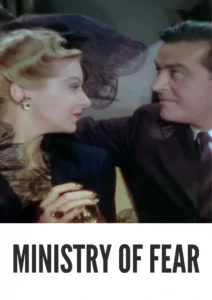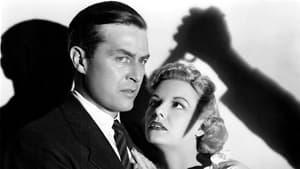Contact: [email protected]
Video Sources 0 Views
- Watch trailer
- Ministry of Fear


Synopsis
Table of Contents
ToggleReview: Ministry of Fear (1944) – A Gripping and Atmospheric Thriller

Introduction
Ministry of Fear, released in 1944, is a captivating thriller directed by Fritz Lang, based on the novel by Graham Greene. Renowned for its atmospheric cinematography, suspenseful plot, and morally ambiguous characters, this classic film continues to intrigue audiences with its exploration of paranoia and deception during wartime. In this review, we’ll delve into the dark and mysterious world of Ministry of Fear and its enduring legacy in the realm of cinematic suspense.
Check The Full Colorized Movies List
Check Our Colorized Movies Trailer Channel
Understanding Ministry of Fear (1944): Director, Cast, and Genre
Directed by Fritz Lang, Ministry of Fear features a talented cast led by Ray Milland and Marjorie Reynolds. The film belongs to the suspense thriller genre, known for its tense atmosphere, intricate plot twists, and psychological depth.
Exploring the World of Ministry of Fear (1944): Plot and Characters
Ministry of Fear follows the story of Stephen Neale, a recently released psychiatric patient who becomes embroiled in a web of intrigue and espionage. As Neale navigates the treacherous landscape of wartime London, he uncovers a sinister plot orchestrated by a shadowy organization known as the Ministry of Fear. With danger lurking around every corner, Neale must rely on his wits and instincts to survive and expose the truth.
The Art of Film Colorization
While Ministry of Fear was originally filmed in black and white, its early colorized version adds a new layer of depth to its atmospheric visuals. The colorization process enhances the film’s moody atmosphere and captures the nuances of its shadowy characters with striking clarity.
Early Colored Films: A Brief History
The history of early colored films is marked by innovation and experimentation as filmmakers sought to enhance the visual appeal of their movies. From hand-tinted frames to pioneering technicolor processes, the evolution of colorization techniques transformed the cinematic landscape, offering audiences a new way to experience the suspense and intrigue of classic thrillers.
Ministry of Fear (1944) and Its Early Colored Version
The decision to release Ministry of Fear in a colorized format was made with the intention of immersing audiences in the atmospheric beauty of its wartime setting and enhancing the film’s visual impact. While some purists may prefer the original black and white version, the early colorized edition of Ministry of Fear adds a new layer of depth to its suspenseful narrative and captures the moral ambiguity of its characters with breathtaking clarity.
The Debate Over Film Colorization
The debate over film colorization continues to divide audiences and industry professionals alike. While some argue that colorization breathes new life into classic films and makes them more accessible to modern audiences, others maintain that it compromises the artistic integrity of the original work. As technology advances and filmmaking techniques evolve, the debate over colorization remains a topic of ongoing discussion within the film community.
Examining Ministry of Fear (1944) as an Early Colored Film
Viewing Ministry of Fear in its early colorized iteration offers audiences a fresh perspective on its atmospheric beauty and suspenseful narrative. The colorization process enhances the film’s moody atmosphere and captures the tension and paranoia of wartime London with stunning clarity. As viewers are drawn into the shadowy world of espionage and deception, they are treated to a visual feast that immerses them in the gripping story of Stephen Neale and his quest for truth.
Influence and Legacy: Ministry of Fear (1944)’s Impact on Cinema
Ministry of Fear is widely regarded as a masterpiece of the suspense thriller genre that continues to influence filmmakers and inspire new generations of cinephiles. Its atmospheric cinematography, suspenseful plot, and morally ambiguous characters have left an indelible mark on cinema, shaping the way thrillers are made and appreciated to this day.
Director’s Cinematic Legacy: Beyond Ministry of Fear (1944)
Fritz Lang’s directorial legacy extends far beyond Ministry of Fear, encompassing a diverse body of work that includes acclaimed films such as Metropolis and M. As one of the most innovative filmmakers of his generation, Lang was known for his ability to craft visually stunning films that explored the darker aspects of the human experience with depth and nuance. Ministry of Fear stands as a testament to his talent and creativity, solidifying his reputation as one of the great auteurs of classic Hollywood cinema.
Themes Explored in Ministry of Fear (1944)
At its core, Ministry of Fear explores themes of paranoia, deception, and the search for truth in a world consumed by war. Through its atmospheric cinematography and morally ambiguous characters, the film offers a nuanced portrayal of the human condition, challenging viewers to confront their own beliefs about right and wrong as they navigate the treacherous landscape of espionage and intrigue.
Reception and Controversy Surrounding Ministry of Fear (1944)
Upon its release, Ministry of Fear received widespread critical acclaim for its atmospheric cinematography, suspenseful plot, and powerhouse performances. While the decision to release the film in a colorized format sparked debate among purists, its enduring popularity has cemented its status as a timeless classic of the suspense thriller genre.
Where to Watch Ministry of Fear (1944) Online
For those eager to experience Ministry of Fear for themselves, the film is readily available on popular streaming platforms such as Amazon Prime Video, Google Play Movies, and iTunes. Whether viewed in its original black and white format or its early colorized iteration, Ministry of Fear offers a cinematic experience that is both gripping and visually stunning.
FAQs About Ministry of Fear (1944)
1. Is Ministry of Fear based on a true story?
No, Ministry of Fear is a fictional film based on the novel by Graham Greene. While the film’s storyline may draw inspiration from real-life events, its characters and plot are works of fiction.
2. Who starred in Ministry of Fear?
Ministry of Fear stars Ray Milland in the role of Stephen Neale, a recently released psychiatric patient who becomes embroiled in a web of intrigue and espionage. He is supported by Marjorie Reynolds, who delivers a memorable performance as the enigmatic femme fatale, Carla Hilfe.
3. What is the central message of Ministry of Fear?
At its core, Ministry of Fear explores the themes of paranoia, deception, and the search for truth in a world consumed by war. Through its atmospheric cinematography and morally ambiguous characters, the film offers a nuanced portrayal of the human condition, challenging viewers to confront their own beliefs about right and wrong as they navigate the treacherous landscape of espionage and intrigue.
4. Why was Ministry of Fear released in a colorized format?
The decision to release Ministry of Fear in a colorized format was made with the intention of immersing audiences in the atmospheric beauty of its wartime setting and enhancing the film’s visual impact. While some purists may prefer the original black and white version, the early colorized edition of Ministry of Fear adds a new layer of depth to its suspenseful narrative and captures the moral ambiguity of its characters with breathtaking clarity.
5. What is the legacy of Ministry of Fear?
Ministry of Fear is widely regarded as a masterpiece of the suspense thriller genre that continues to influence filmmakers and inspire new generations of cinephiles. Its atmospheric cinematography, suspenseful plot, and morally ambiguous characters have left an indelible mark on cinema, shaping the way thrillers are made and appreciated to this day.
6. Are there any sequels or remakes of Ministry of Fear?
No, there have been no official sequels or remakes of Ministry of Fear. However, the film’s enduring popularity has inspired countless reinterpretations and homages in various media. Nonetheless, none have captured the atmospheric beauty and suspenseful narrative of the original 1944 classic.
7. Where can I watch Ministry of Fear online?
For those eager to experience Ministry of Fear for themselves, the film is readily available on popular streaming platforms such as Amazon Prime Video, Google Play Movies, and iTunes. Whether viewed in its original black and white format or its early colorized iteration, Ministry of Fear offers a cinematic experience that is both gripping and visually stunning.
Conclusion
In conclusion, Ministry of Fear (1944) stands as a gripping and atmospheric thriller that continues to captivate audiences with its suspenseful plot, morally ambiguous characters, and moody cinematography. Whether viewed in its original black and white format or its early colorized iteration, Fritz Lang’s insightful direction and the stellar performances of the cast offer a cinematic experience that is both thrilling and visually stunning. As viewers are drawn into the shadowy world of espionage and intrigue, they are treated to a visceral journey that challenges their beliefs about right and wrong and leaves a lasting impact on their understanding of the human condition. Ministry of Fear remains a timeless classic that continues to enthrall and inspire audiences around the world.















